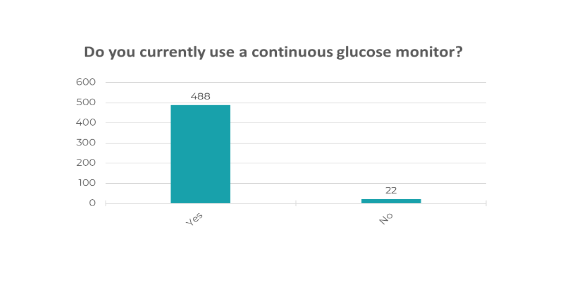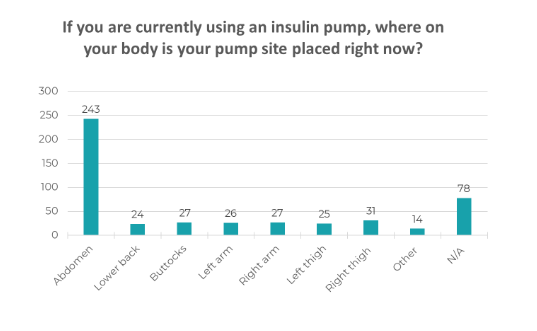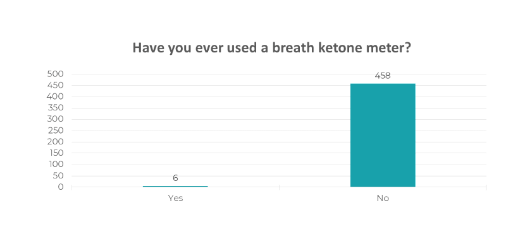
Sign up for a new account.
And get access to
The latest T1D content
Research that matters
Our daily questions
Sign up by entering your info below.
Reset Your Password
Don't worry.
We will email you instructions to reset your
password.
We learn something new every day from the T1D Exchange Online Community’s Question of the Day responses. This past month, the community was especially inspiring!
Here’s what we learned from the 3 most popular questions of September 2022:

1. Do you currently use a continuous glucose monitor?
September’s most popular question this month had over 500 responses—asking our community if they currently use a continuous glucose monitor (CGM). 95% of the community responded with “yes” they are currently using a CGM system. Several comments from the community shared that using a CGM has improved both their A1c and their mental health—reminding us that the benefits of today’s diabetes technology are about more than just numbers.
Inspiring comments from the community included:
- “I would not go back to 6x daily finger sticks. The ability to have high and low alarms has reduced the mental load of managing T1D and improved my life.”
- “Time to teach an old dog new tricks! I can’t imagine ever going back to 1954!”
- “T1D since 1964, using a Dexcom since 2009 and Tandem X2 since 2021. Put it all together—I have zero hypos with an A1c 5.4 percent.”
- “If I had to choose between my Dexcom CGM and my pump, I’d go with my CGM.”
- “Two big takeaways since beginning on the Dexcom last year: 1. I haven’t had a single hypoglycemic event requiring assistance. 2. When calibrating a sensor, I do four finger sticks and use the average—I’ve seen them vary by as much as 70 points. This explains the difficulties I had before using the CGM.”
- “Cannot imagine life without Dexcom. It’s helped me improve my control so much—which unfortunately means I am scared to switch jobs and end up with an insurance that won’t cover it. I truly believe that CGMs should be considered an essential supply for T1s because of the long term benefits it brings.”
*Comments have been edited slightly for clarity as needed.

2. If you are currently using an insulin pump, where on your body is your pump site placed right now?
Our second most popular question asked our community if they are currently using an insulin pump, where on their body is their pump site place at this moment. The most popular option—with 49% of the responses—was the abdomen. The other 51% of responses were spread equally across other site options on the body. Many comments included the importance of rotating pump sites and which locations tend to offer the best insulin absorption.
Interesting comments from the community included:
- “I’ve been using a pump since 1985. During that time I have attempted placing the infusion cannula on the front of my thighs, which had been a favorite site when I utilized syringe injections. Every time I try this, there is a mild discomfort at first, which develops into frank pain at the site. So, I use every bit of my abdomen and buttocks in a regular rotation pattern.”
- “I thought with the Tandem you weren’t supposed to put it anywhere but the abdomen? I’m running out of places to insert the tubing!”
- “I used my abdomen for years and absorption became an issue so now I put the site above my waistline on either side. Same for my Dexcom CGM.”
- “I sleep on my sides, so I cannot use my thighs. I am using the top of my left leg now.”
- “For those of you who use your lower back and buttocks, do you ever pull it out while sleeping? Because of neuropathy, I am constantly tossing and turning and am wondering if that’s a factor and have avoided those areas.”
*Comments have been edited slightly for clarity as needed.
3. Have you ever used a breath ketone meter?
Our third most popular question this month asked our community if they have ever used a breath ketone meter. A ketone breath meter is a device that measures the amount of acetone in your breath, offering an option to check for ketones without using urine or blood. The majority of the community —98%—answered “no” and shared within the comments that they had never heard of a breath ketone meter before. Two community members shared where they’ve found breath ketone meters on Amazon. This was a wonderful example of how members of the community support and teach each other.
Thoughtful comments from the community included:
- “Having just found out that ketones can happen even when my blood sugar is in a normal range, this is something I think I should ask about at my next endo visit!!”
- “I found this Ketone Breath Meter on Amazon and I’m thinking about getting one.”
- “I’ve never heard of it. Tell me more.”
- “Bought one on Amazon that came from Europe. It never worked, wasted $100.00.”
*Comments have been edited slightly for clarity as needed.
Thank you to every member of the T1D Exchange Online Community for sharing your experiences. If you are not already a member of our Online Community, join us by clicking the “Join” button in your upper right corner!









1 Comment